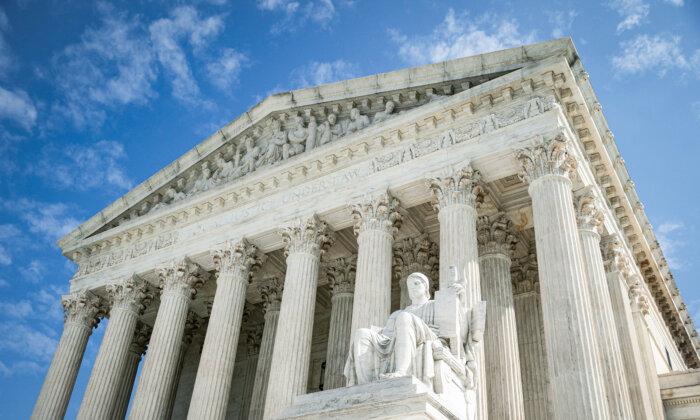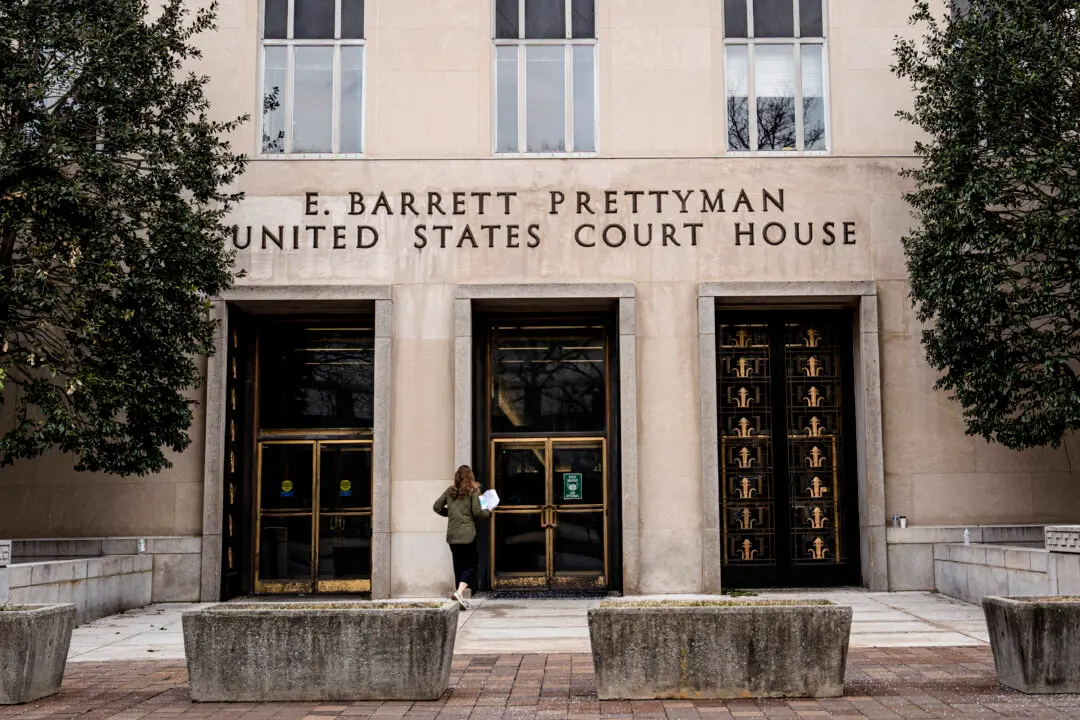The U.S. Supreme Court seemed inclined on Nov. 28 to rule against government attorneys advocating for a refined definition of double jeopardy and giving immigration courts more deference.
Oral argument in the two cases—McElrath v. Georgia and Wilkinson v. Garland—focused on the scope of courts’ powers in reviewing decisions made by others in the legal system.
In the first case, Georgia’s Solicitor General Stephen Petrany defended the state Supreme Court’s decision to invalidate the jury acquittal of a man who stabbed and killed his adoptive mother.
The jury in Mr. McElrath’s trial found him guilty, but mentally ill, of felony murder and aggravated assault; as well as not guilty of malice murder, or a homicide committed with express or implied malice, by reason of insanity.
This created an apparent contradiction that led Mr. Petrany to defend the state court declaring the verdict void.
Richard Simpson, who represented Mr. McElrath, contended that the “most fundamental principle of double jeopardy law, going back hundreds of years before even the adoption of the Constitution, is that if a jury in a court with jurisdiction returns a verdict of acquittal, that that verdict is final.”
Mr. Petrany maintained that the Fifth Amendment’s protection against double jeopardy, or being tried for the same crime, didn’t apply because there wasn’t a verdict in the first place.
“Under Georgia’s narrow, sensible repugnancy rule, a jury cannot issue special affirmative findings that facially contradict each other,” he told the justices. “These incoherent, contradictory statements do not constitute a verdict in the first place.”
The justices, however, seemed skeptical of the idea that a repugnant verdict was void. They also suggested Mr. Petrany’s position didn’t afford juries enough flexibility.
Jurors, some of the justices indicated, shouldn’t necessarily be questioned even if they advance what appears to be a contradictory verdict.
“I mean ... when a jury comes back with inconsistent verdicts, we don’t really know what happened,” said Justice Elena Kagan. “I mean, one possibility of what happened is the jury made a humdinger of a mistake.
“Another possibility of what happened is that the jury made no mistake at all, but instead decided to compromise something out or decided to show leniency of a kind that it is within the right of a jury to show.
“And so too here, the jury might have made a humdinger of a mistake in the way that you’re suggesting but, in addition, the jury might have decided to compromise things out or to show leniency.”
Justice Neil Gorsuch similarly asked: “The minute you admit that it could be a product of leniency or compromise, we’re done, aren’t we?”
A key part of Mr. Petrany’s argument was his attempt to distinguish verdicts involving special findings on insanity and those verdicts that plainly declare a defendant not guilty.
Removing Illegal Immigrants
The second case, Wilkinson v. Garland, involved an illegal immigrant who overstayed his visa but sought to avoid removal by claiming that he faced a type of unusual hardship protected under the Immigration and Nationality Act (INA).An immigration court and the Board of Immigration Appeals decided that the man’s circumstances didn’t qualify as the type of hardship that would exempt him from removal.
When the man, Situ Wilkinson, asked an appellate court to review the decision, the court decided it lacked jurisdiction because of how the INA limited judicial review of the immigration court’s decisions.
The text of the INA allows the Justice Department, specifically through the attorney general, to block an immigrant’s removal if they faced “exceptional and extremely unusual hardship.”
The law includes a caveat that allows federal courts to review “constitutional claims or questions of law” related to how the Justice Department decided an immigrant’s case.
It’s unclear, however, what precisely “constitutional claims or questions of law” means in terms of what federal courts can review, and multiple appellate courts have taken conflicting positions.
Some of the justices on Nov. 28 suggested that the government’s position sounded the same as the losing position in Guerrero-Lasprilla v. Barr.
Decided in 2020, that case focused on a different question surrounding immigration but nonetheless held that “questions of law” include “mixed questions” of law and fact.
This ruling allowed courts to review DOJ’s administrative court decisions to ensure they adhered to legal standards.
How that should practically occur within courts was the subject of debate during oral argument.
“As this Court held in Guerrero-Lasprilla, the statutory term ‘questions of law’ includes the application of legal standards to settled facts,” said Jaime Santos, who was representing Mr. Wilkinson.
In questioning Ms. Santos, justices sought to clarify how reviewing the hardship exemption wouldn’t intrude too much into the immigration courts’ discretionary evaluation of immigrants’ circumstances.
“Doesn’t it seem like you’re just seeking, or that your client was seeking, a reweighing of those facts and so that ... they really would be not subject to review?” Justice Barrett asked at one point.
Ms. Santos argued that the factual points made by a judge wouldn’t be reviewable by a court outlined in Article III of the Constitution. However, an appellate court could review “the ultimate determination of whether” the set of facts “satisfies the statutory standard.”
Justice Ketanji Brown-Jackson questioned whether she and the other justices should delineate between different types of mixed questions rather than overruling the precedent in Guerrero.
Assistant to the Solicitor General Colleen Sinzdak told the Court that Mr. Wilkinson’s case involved “a factual determination and that’s an exercise of agency discretion. That is not a legal conclusion.”
In a series of somewhat contentious exchanges, the justices sought to resolve whether courts should be able to rule that other judges abused their discretion in deciding cases.
Some of the exchanges centered on a hypothetical that Justice Amy Coney Barrett raised to test the limits of immigration judges’ discretion.
“Imagine the worst case possible that, say, the non-citizen has one child who has cancer, there’s no other relative in the country, they have no support network, he’s the sole breadwinner,” Justice Barrett posited.
“So let’s just posit that that’s—that’s a heartland case for hardship under the statute.”
In multiple exchanges, Ms. Sinzdak maintained that another court wouldn’t be able to review that immigration judge’s decision unless it was reviewing a particular legal standard.
She said that while courts typically have broader authority to address lower courts’ discretion, the INA limited that authority over immigration courts.







